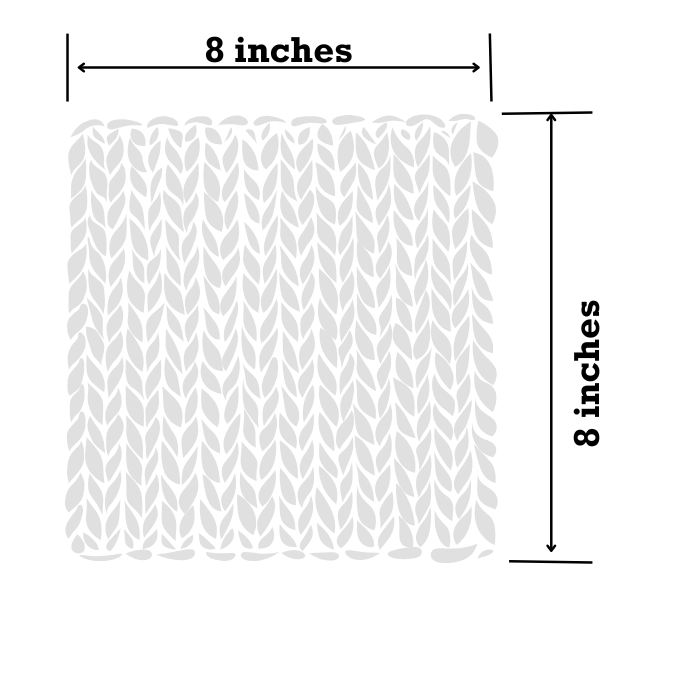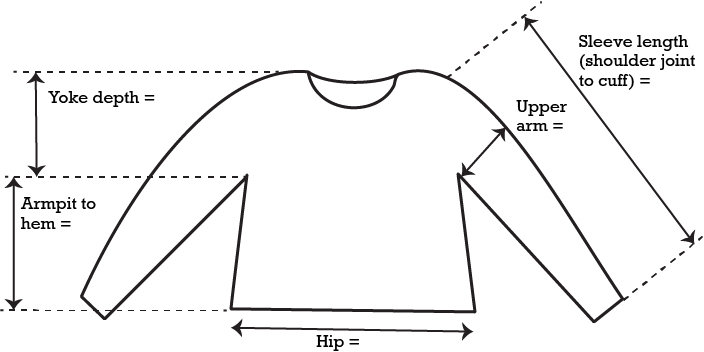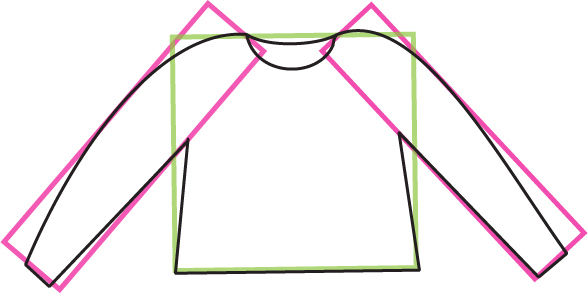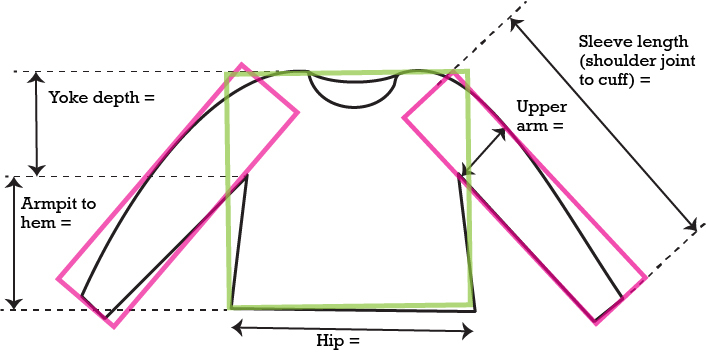How to Estimate Yarn for a Project
Construct a gauge swatch using the exact same yarn and needles or hook that you will use for your project. Your pattern will tell you what stitch pattern to use. At times you may need to construct more than one gauge swatch for a project.
A few thoughts about a good gauge swatch:
- Make your swatch large enough so that you can measure a 4-square-inch area where stitches are not distorted by cast on, bind off or edge stitches. A swatch that is at least 8 inches square is ideal.
- For swatches in the round, you will need to lay your tube flat and be able to measure the four square inches inside of that flat tube.
- Measure gauge on your unwashed swatch.
- Wash your swatch as you would your finished project, dry thoroughly, and then measure gauge again.
- If you are happy with your gauge then weigh your gauge swatch and measure the total area of your swatch.
Calculate the amount of yarn you used in your gauge swatch

For our example:
Weight of Gauge Swatch: 0.7 oz or 22 grams
Area of Swatch: 8 x 8 = 64 square inches
Calculate how many ounces or grams of yarn you used for each square inch of knit or crochet fabric by taking your swatch weight and dividing by the area of the swatch:
0.7 oz / 64 square inches = 0.0109 oz per square inch
OR
22 grams / 64 square inches = 0.3438 grams per square inch.
Estimate the area of your project
Let’s try a simple scarf.

What are the length and width of your scarf?
As an example, a scarf might be 72 inches long and 8 inches wide.
The area of the scarf would then be 72” x 8” = 576 square inches.
Remember that your gauge swatch took 0.3438 grams of your yarn per square inch.
How many grams of your yarn will you need to make 576 square inches?
0.3438 g x 576 sq. in. = 198.03 g
1 sq. in.
Let’s suppose that the yarn you are using comes in 100 gram skeins.
198.03 / 100 = 1.98 skeins. . . . You will need two skeins to knit the scarf.
For this project though we are going to add fringe to the project.
Estimate how long you will want your fringe. . . . Maybe 3 inches long per piece.
Estimate how many strands of fringe your will want per inch. . . . Maybe 6 strands per inch.
6 strands x 8 inches = 48 strands for each end x 2 ends = 96 total strands.
3 inches x 96 strands = 288 inches of yarn for the fringe OR 288 / 36 = 8 yards of yarn.
Your yarn comes in 100 gram skeins with 220 yards of yarn per skein.
Your scarf will use how many yards? (220 yards / 100 grams) x 198.03 grams = 435.66 yards
2 skeins of yarn will be 440 yards. 440 – 435 = 5 yards left over for fringe.
Not quite enough. You will need to decide if you construct your scarf slightly shorter or eliminate the fringe or purchase the third skein of yarn.
How about a simple sweater?
Use the garment schematic and insert your own desired finished measurements:
- These measurements will be the finished garment measurements so will include your own personal body measurements plus the desired ease.
- You may choose to use the pattern measurements if you plan to simply knit to the pattern without making any changes for personal fit.

Create simple shapes to estimate the area:

Use your dimensions to calculate the areas:
- Keep in mind that you may need to add multiples of certain areas:
- Front and back
- Two arms that each have two sides

Total Area for the Sleeves
First, we will start by calculating the area of the sleeves using our sleeve measurements taken laid flat. We then multiply these measurements by 4 to account for both sides of each sleeve.
Upper Arm Width * Sleeve Length * 4 = Sleeves Area
Total Area for the Body
Next, we will calculate the area of the body by multiplying the total garment width by its length (based on the yoke depth and armpit to hem length). In this case, we will multiply this number by 2 for the front and back of the sweater body.
(Yoke Depth + Armpit to Hem Length) * Hip Width * 2 = Body Area
Total Garment Area
Now that we’ve calculated these two measurements, we can add them together to get the total area of our sweater.
Sleeves Area + Body Area = Total Area

As an example:
Knit or Crochet Area for the above example:
Sleeves Area: (5 inches x 24 inches) x 4 sides = 480 square inches
Body Area: ((9 inches + 15 inches) x 22 inches) x 2 sides = 1056 square inches
Total Area : 480 + 1056 = 1536 square inches.
We are going to use the same yarn as previous so we will need:
0.3438 grams/square inch x 1536 square inches = 528.08 grams of yarn.
Our yarn has 220 yards in 100 grams skeins.
528.08 grams/100 gram skein = 5.28 skeins
We will use (220 yards / 100 grams) x 528.08 grams = 1161.78 yards of yarn.
Please notice that by estimating the shapes we build in a bit of a cushion for swatching.
If the crafter decides to make major changes to the area of the piece, new calculations should be made.
